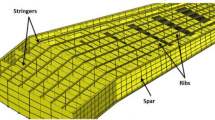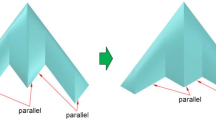Abstract
The reduction of the aircraft weight is a great challenge for constructors, allowing them to cut down on fuel consumption and to increase the load carrying. This can be achieved by improving the properties of materials of aircraft parts. One of the most massive parts is the wing itself. In fact, according to a recent review of Aircraft Wing Mass Estimation Methods made by Dababneha and Kipouros (Aerosp Sci Technol, https://doi.org/10.1016/j.ast.2017.11.006, 2017) an aircraft wing could reach 8811 kg (Megson in Aircraft structure for engineering students, 3rd edn. Arnold, London, (1999) for an Airbus A320-200 and even 39,914 kg (Anderson in Fundamentals of aerodynamic, 3rd edn. McGraw-Hill, Boston, 1999) for a Boeing 747-100 since it is a long-range aircraft. Thus, it seems very interesting to act upon the material choice of wing components but without harming structure stiffness. In fact, composite integration has a direct impact on the stress and the weight of the wing which matters a lot in the conception of an aircraft wing. Such a complex problem requires indeed a multidisciplinary approach based on aerodynamics and structural analysis of both composite material and aluminum alloy. Solving this problem could be of great interest for both industrialists and researchers since it would lighten the path towards full composite wing integration. In this work, we propose a double-approach numerical method to study the effect of different composite materials integrated into aircraft wing skin stiffeners. By this way, this investigation aims to show the improvement given by composite materials to the structure and the achieved mass reduction after cautious integration, taking into consideration the stiffness of structure after load application. It also gives a method based on the best yield on weight ratio to compare the different possibilities of integrations to choose the most relevant material, its stacking and fibers orientations. For that, we relied on both analytical calculation and finite element analysis. A Matlab code was developed to determine structure response to loading such as longitudinal and shear stress and to estimate the global structure’s weight for different materials. We started by working on a wing made from the aluminum alloy AA2024 and then we integrated various composite materials like Glass fiber, S-glass/epoxy, and hm graphite/epoxy. Also, an investigation of the variability of stacking sequences and plies orientations was undertaken. As a result, we obtained a clear assessment of the potential of each material. We finally created, inspired by the Airbus technical data, an accurate finite-element model of an aircraft’s wing that served to study the structural resistance with Abaqus. Coherent results for the selected composite material and for its ply’s stacking and orientation were found.










Similar content being viewed by others
References
Dababneha O, Kipouros T (2017) A review of aircraft wing mass estimation methods. Aerosp Sci Technol. https://doi.org/10.1016/j.ast.2017.11.006
Megson THD (1999) Aircraft structure for engineering students, 3rd edn. Arnold, London
Anderson JD (1999) Fundamentals of aerodynamic. McGraw-Hill, Boston
John MH, Ho CY (eds) (1996) Structural alloys handbook. CINDAS/Purdue University, West Lafayette
Kundu AK (2010) Aircraft design, 1st edn. Cambridge University Press, New York
Triet NM, Viet NN, Thang PM (2015) Aerodynamic analysis of aircraft wing. VNU J Sci Math Phys 31(2):68–75
Bai Yuguang, Sun Dongke, Lin Jiahao, Kennedy David, Williams Fred (2012) Numerical aerodynamic simulations of a NACA airfoil using CFD with block-iterative coupling and turbulence modeling. I J Comput Fluid Dyn 26(2):119–132
Yin Q, Druesne F, Lardeur P (2016) The certain generalized stresses method for static analysis of multilayered composite plates with variability of material and physical properties. Compos Struct 140:360–368
Gay D, Hoa SV, Tsai SW (1997) Composite materials, design and, applications edn. Hermès, Paris
Valdidni CIA, Imbert JF (1999) Composite stress manual. Aerospatiale, Paris, p 1999
Acknowledgements
The authors would like to present their sincere thanks to the Applied Mechanics and Systems Research Laboratory and the Aviation school of Borj El Amri members, friends and colleagues for their continuous support and encouragement. They also would like to gratefully acknowledge the guidance and supervision of Pr. Mondher Yahiaoui and Pr Moez Chafra who provided insight and expertise that greatly assisted the research.
Author information
Authors and Affiliations
Corresponding author
Rights and permissions
About this article
Cite this article
Doggui, M.M., Touihri, W., Yahiaoui, M. et al. Numerical investigation on aircraft wing stiffener composite material integration. AS 2, 137–145 (2019). https://doi.org/10.1007/s42401-019-00027-9
Received:
Revised:
Accepted:
Published:
Issue Date:
DOI: https://doi.org/10.1007/s42401-019-00027-9




